LAB REPORT
Science and Technology Making Headlines
March 4, 2016

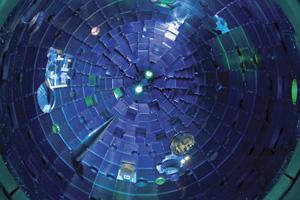
A technician checks a diagnostic in the target chamber of the National Ignition Facility. Image courtesy of Joe McNally/Getty Images.
A giant among giants
To do big research, sometimes you need some massive machines. Popular Mechanics recently noted 16 facilities that have "done out-there" work in the last decade, whether hunting for mysterious particles, looking for distant stellar explosions, or just generating lightning to see what happens.
Lawrence Livermore’s National Ignition Facility fits the bill: a 10-story chamber where 192 different lasers focus in on particles of hydrogen, attempting to compress them until a fusion reaction occurs. Five hundred trillion watts of energy are aimed toward the small target in the midst of it all, with the hope that someday more energy is produced than what is put in — the holy grail of fusion.

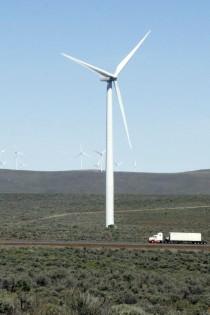
New masted wind turbines turn out 2.3 megawatts of energy.
Renewables are blowing in the wind
Despite energy turmoil around the world, renewables are gaining traction.
Investors show some trepidation investing in wind, despite the fact that more advanced turbines have been developed and installed worldwide. Jeff Roberts, deputy program director for energy at Lawrence Livermore, points out that 100-kilowatt wind turbines in outlying areas of the laboratory are old news. New, masted turbines, which tower 70 feet above ground, operate at 2.3 megawatts.
“One new turbine could replace 23 of the old turbines,” he said.
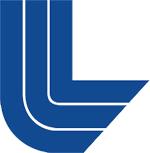
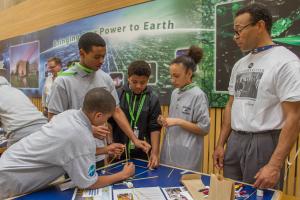
MBK students attempt to build the tallest freestanding tower out of spaghetti as one of the hands-on activities offered at the Laboratory.
My Brother's Keeper
This week the Laboratory hosted more than 180 underserved and mostly minority boys and girls from Bay Area schools as part of the White House’s “My Brother’s Keeper” (MBK) initiative.
Last summer, the Department of Energy, which joined the MBK alliance and task force, chose the Lab as a site for the first of several MBK events at the national laboratories, drawing more than 60 youth from Oakland, San Francisco and Tracy.
The goal of the program is to reach out to underprivileged children to get them interested in science, technology, engineering and math (STEM).

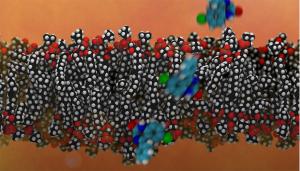
In a composite of two images, cyan-colored drug molecules are shown passing through a cell membrane. Graphic by Tim Carpenter/LLNL
The nerve of those agents
Imagine you wanted to know how much energy it took to bike up a mountain, but couldn't finish the ride to the peak yourself. So, to get the total energy required, you and a team of friends strap energy meters to your bikes and ride the route in a relay, then add up your individual energy inputs.
Researchers at Lawrence Livermore are currently using a similar approach, powered by LLNL's world-class supercomputers, to simulate the energy requirements for potential nerve agents to permeate cell membranes — shaving weeks of compound testing by determining in advance how readily they'll enter cells to perform their activity.
"Instead of having one [drug molecule] starting from one side of the membrane, you have it starting at a hundred different points through the membrane," said Timothy Carpenter, a staff scientist in LLNL's Biochemical and Biophysical Systems Group.

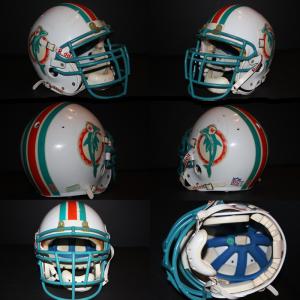
Lawrence Livermore is working with Autodesk to build better helmets.
Head start on better helmets
Using helmet designs that can only be manufactured using 3-D printers, scientists are developing a solution to brain injuries suffered in sports.
A group of researchers at Lawrence Livermore National Laboratory are currently engaged in an 18-month study in collaboration with Autodesk Research, a 3-D design software company, to design the helmet of the future.
The group is investigating whether 3-D printed microstructures within helmet design can absorb more of the momentum of a collision than current helmet technology. To design the structure of the helmet, they're starting with a question: What part of the impact causes the concussion?

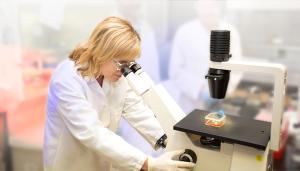
Monica Borucki, a scientist from Lawrence Livermore Lab's Biosciences and Biotechnology Division, looks at cell lines used for viral propagation.
The virus detectives
Lawrence Livermore scientists are hunting for clues for the transmission of the deadly Middle East Respiratory Syndrome Coronavirus (MERS-CoV), an RNA virus related to Severe Acute Respiratory Syndrome (SARS).
The team used new genetic sequencing technology and bioinformatics analysis to define how a novel and deadly respiratory virus changes when it passes from one host to another.
MERS-CoV can cause serious respiratory illness, fever, cough and shortness of breath in carriers, and has killed roughly 40 percent of diagnosed patients. Since first being reported in Saudi Arabia in 2012, scientists have determined MERS likely originated in camels, but not much is known about how it is transmitted to humans or other animals.





